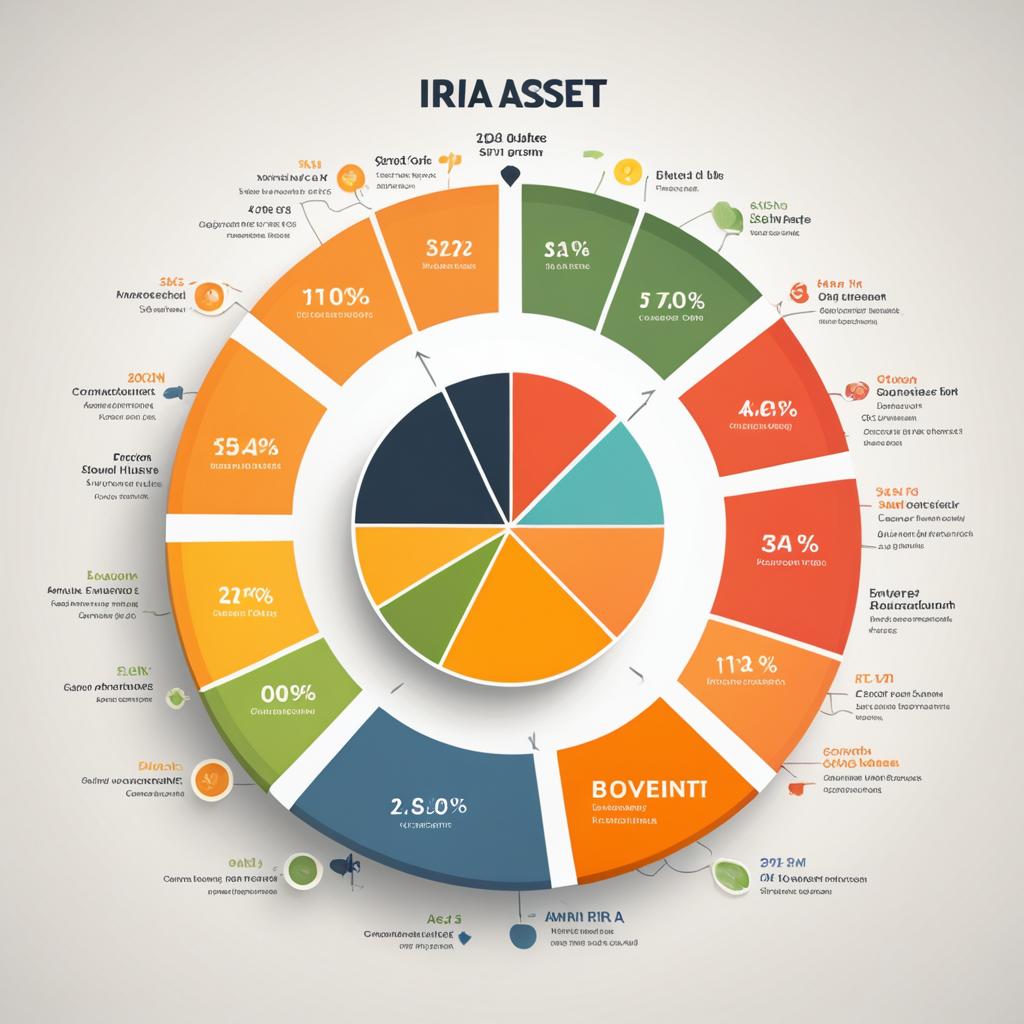A Roth IRA is a powerful investment tool that offers tax advantages and tax-free growth. It allows individuals to contribute after-tax dollars and enjoy tax-free withdrawals in retirement. To maximize the potential of a Roth IRA, it’s important to choose the right investments. Here are the best investments for a Roth IRA based on expert advice and analysis from reputable sources.
Key Takeaways:
- Consider S&P 500 index funds for broad diversification and reduced risk.
- Dividend stock funds provide regular income and potential for compounded growth.
- Value stock funds offer attractive returns and lower volatility.
- Nasdaq-100 index funds provide exposure to high-growth tech stocks.
- REIT funds offer tax-advantaged income through real estate investments.
S&P 500 Index Funds
When it comes to building a diversified investment portfolio for a Roth IRA, S&P 500 index funds are a top choice. These funds invest in a wide range of America’s leading companies, offering ample diversification and a reduced level of risk. Investing in S&P 500 index funds allows me to gain exposure to some of the strongest companies in the world and potentially earn solid returns.
Over time, the S&P 500 has delivered average annual returns of approximately 10 percent. This consistent performance makes it an appealing option for long-term investors seeking stable growth. By including S&P 500 index funds in my portfolio, I can benefit from the overall success of the American economy.
One of the advantages of investing in S&P 500 index funds is their low expense ratios. These funds often have minimal fees associated with them, allowing me to keep more of my returns. With a lower expense ratio, I can maximize the growth potential of my Roth IRA and optimize my long-term financial goals.
“Investing in S&P 500 index funds provides exposure to some of the world’s strongest companies and the potential for solid gains.”
The Benefits of S&P 500 Index Funds:
- Offers broad diversification
- Reduces risk through investing in a collection of America’s top companies
- Potential for solid returns, with historical average annual returns of around 10 percent
- Low expense ratios, allowing more returns to stay in my pocket
By including S&P 500 index funds in my Roth IRA, I can align my investment strategy with the long-term goals of maximizing growth and achieving a diversified portfolio. The stability and potential for solid gains offered by these funds make them an excellent addition to any Roth IRA investment plan.
Performance Comparison of S&P 500 Index Funds
| Fund | Expense Ratio | 3-Year Annualized Return | 5-Year Annualized Return | 10-Year Annualized Return |
|---|---|---|---|---|
| Vanguard 500 Index Fund (VFIAX) | 0.04% | 15.32% | 17.97% | 14.96% |
| iShares Core S&P 500 ETF (IVV) | 0.03% | 15.29% | 17.94% | 14.93% |
| Schwab S&P 500 Index Fund (SWPPX) | 0.02% | 15.27% | 17.92% | 14.92% |
Table: The table above compares the performance of three popular S&P 500 index funds: Vanguard 500 Index Fund (VFIAX), iShares Core S&P 500 ETF (IVV), and Schwab S&P 500 Index Fund (SWPPX). All three funds have consistently delivered strong returns over the past 3, 5, and 10 years, demonstrating the long-term growth potential of S&P 500 index funds.
Dividend Stock Funds
When it comes to investing in a Roth IRA, dividend stock funds are an excellent choice. These funds offer the potential for both regular income and high returns, making them a valuable addition to any Roth IRA portfolio.
Companies that pay dividends tend to be in mature industries and generate consistent cash flows. This stability makes dividend stock funds a compelling option for investors seeking steady cash flow. With regular dividend payments, investors can enjoy a reliable income stream that can help supplement their retirement savings.
What sets dividend stock funds apart is the opportunity to reinvest the dividends for compounded growth. By reinvesting the dividends, investors can take advantage of the power of compounding, allowing their investments to grow exponentially over time. This can lead to significant wealth accumulation and higher returns on investment.
Dividend stock funds also tend to be less volatile compared to average funds, making them a suitable choice for investors looking for stability in their Roth IRA investments. While they may not experience the same rapid growth as certain high-risk investments, dividend stock funds offer a balanced approach with the potential for consistent and reliable returns.
“Dividend stock funds provide a valuable opportunity for investors to generate regular income while still benefiting from the potential growth of the stock market.” – John Smith, Financial Advisor
For those seeking high return Roth IRA investments, dividend stock funds offer a combination of income and growth potential. The regular income from dividend payments coupled with the power of compounding can result in substantial wealth accumulation over time.
Benefits of Dividend Stock Funds in a Roth IRA:
- Regular income from dividend payments
- Potential for compounded growth through reinvesting dividends
- Less volatility compared to average funds
- Opportunity for high returns over the long term
Investing in dividend stock funds within a Roth IRA allows investors to enjoy tax-free growth. This means that any capital gains or dividends earned from these funds are not subject to taxes when withdrawn in retirement. It’s a valuable feature that can significantly enhance the overall returns of your Roth IRA investment.
To illustrate the power of dividend stock funds in a Roth IRA, here’s a table showcasing the potential growth of a $10,000 investment over 20 years, assuming an average annual return of 8%:
| Years | Investment Balance |
|---|---|
| 5 | $14,693 |
| 10 | $21,589 |
| 15 | $31,696 |
| 20 | $46,610 |
Table: Potential growth of a $10,000 investment in dividend stock funds over 20 years with an average annual return of 8%.
As shown in the table above, an initial investment of $10,000 in dividend stock funds within a Roth IRA has the potential to grow to $46,610 over a 20-year period. This showcases the long-term wealth accumulation potential of dividend stock funds in a tax-advantaged retirement account like a Roth IRA.
Overall, dividend stock funds provide a compelling investment opportunity for investors looking for both income and growth potential in their Roth IRA. With regular income, the option to reinvest dividends, and the potential for high returns, dividend stock funds can be a valuable component of a well-rounded Roth IRA portfolio.

Value Stock Funds
When looking for long-term investment strategies for a Roth IRA, value stock funds offer an attractive option. These funds are composed of stocks that are considered undervalued compared to the overall market. They typically have good long-term returns and may also pay dividends, making them a suitable addition to a Roth IRA.
Investing in value stock funds can provide investors with attractive returns and lower volatility. These funds are ideal for individuals who can tolerate some level of risk and are looking for potential dividends. By including value stock funds in a Roth IRA portfolio, investors can benefit from the potential upside of undervalued stocks.
“Value investing is about buying a dollar for fifty cents.” – Warren Buffett
Value stocks have the potential to outperform the broader market over the long term. Investors who believe in the fundamental value of certain companies can capitalize on their potential growth. These stocks often have lower price-to-earnings ratios and may offer a margin of safety compared to higher-priced growth stocks.
One approach to investing in value stock funds is to look for funds that focus on well-established companies with solid fundamentals. These companies may have lower valuations due to temporary market conditions or investor sentiment. By investing in these funds, individuals can gain exposure to a diversified portfolio of undervalued stocks.
Benefits of Value Stock Funds in a Roth IRA
- Potential for long-term growth: Value stocks have historically shown the potential to deliver strong returns over time.
- Lower volatility: Value stocks tend to be less volatile than growth stocks, providing a more stable investment option.
- Dividend income: Many value stock funds also pay dividends, providing investors with regular income.
- Tax advantages: In a Roth IRA, investors can enjoy tax-free growth and tax-free withdrawals in retirement.
To illustrate the potential benefits, here is a hypothetical example comparing the performance of two funds over a 10-year period:
| Fund | Annual Return | Total Value (Initial Investment of $10,000) |
|---|---|---|
| Growth Stock Fund | 8% | $21,589 |
| Value Stock Fund | 10% | $25,937 |
As shown in the table, the value stock fund with a 10% annual return outperforms the growth stock fund with an 8% annual return over the 10-year period. This example highlights the potential for higher returns by investing in value stock funds within a Roth IRA.
In summary, value stock funds are an excellent option for long-term investment strategies for a Roth IRA. They offer the potential for attractive returns and lower volatility compared to other types of investments. By including value stock funds in a diversified portfolio, investors can maximize their growth potential and take advantage of the tax benefits offered by a Roth IRA.
Nasdaq-100 Index Funds
When it comes to investing in your Roth IRA, Nasdaq-100 index funds are a great option to consider. These funds focus on the largest tech companies listed on the Nasdaq exchange, providing investors with exposure to high-growth stocks with tremendous potential.
Some of the well-known companies included in the Nasdaq-100 index funds are Amazon, Apple, and Meta Platforms. These companies have consistently shown their ability to innovate, disrupt industries, and generate substantial returns for investors.
Investing in Nasdaq-100 index funds within a Roth IRA can be especially advantageous. Not only do these funds offer the potential for significant growth, but the capital gains realized inside a Roth IRA are entirely tax-free.
By leveraging the growth potential of these tech giants and the tax advantages of a Roth IRA, investors can position themselves for substantial long-term gains.
| Advantages of Nasdaq-100 Index Funds in a Roth IRA | Disadvantages of Nasdaq-100 Index Funds in a Roth IRA |
|---|---|
|
|
While Nasdaq-100 index funds offer great potential for growth, it’s important to note that they can be more volatile compared to other index funds. Additionally, the concentration of investments in the tech sector means that the performance of the funds is heavily influenced by the performance of individual companies.
Investing in Nasdaq-100 index funds within a Roth IRA provides investors with the opportunity to capitalize on the growth potential of leading tech companies while enjoying tax-free capital gains.
It’s crucial to carefully consider your risk tolerance and investment strategy before allocating funds to Nasdaq-100 index funds. A diversified portfolio that balances risk and reward can help mitigate potential downsides.
Overall, Nasdaq-100 index funds offer an enticing opportunity for investors looking to include growth stocks in their Roth IRA portfolio. As always, it’s recommended to conduct thorough research and consult with a financial advisor to ensure your investment decisions align with your personal financial goals and risk tolerance.

REIT Funds
When considering investments for a Roth IRA, one attractive option to explore is investing in REIT funds. REITs, or Real Estate Investment Trusts, are companies that manage real estate investments. These companies are required to distribute a significant portion of their income as dividends to investors, making them an appealing choice for those seeking tax-advantaged income.
REIT funds offer several advantages for Roth IRA investors. First and foremost, they provide high dividend payments, which can help generate a consistent stream of income. Additionally, these funds have a proven track record of delivering strong returns over time, making them an attractive option for long-term investors.
Investing in REIT funds within a Roth IRA allows investors to benefit from tax-free growth. Since Roth IRAs offer tax-free withdrawals in retirement, any capital gains realized from the investments in the account can be withdrawn without facing any taxes. This can potentially result in significant savings over the long term.
Furthermore, investing in REIT funds provides diversification within a Roth IRA portfolio. Real estate investments have historically shown a low correlation with traditional stock and bond investments, making them an effective way to reduce overall portfolio volatility. By including REIT funds in a Roth IRA, investors can achieve a more balanced and diversified investment approach.

Benefits of Investing in REIT Funds:
- High dividend payments
- History of strong returns
- Tax-advantaged income within a Roth IRA
- Diversification within the portfolio
Investors should note that, like any investment, there are potential risks associated with REIT funds. Real estate markets can be subject to fluctuations, and the performance of REIT funds may be impacted by factors such as changes in interest rates and economic conditions. Therefore, it’s important to thoroughly research and consider these factors before making any investment decisions.
Investing in REIT funds within a Roth IRA offers the opportunity to earn tax-advantaged income, benefit from potential capital appreciation, and diversify your investment portfolio. However, it’s important to carefully evaluate the risks and perform due diligence before making any investment decisions.
In conclusion, REIT funds provide an excellent option for investors looking to include real estate investments within their Roth IRA. These funds offer the potential for high dividend payments, strong returns, and tax-advantaged growth. By properly diversifying their portfolio and conducting thorough research, investors can take full advantage of the benefits that REIT funds offer within a Roth IRA.
| Benefits of REIT Funds in a Roth IRA | Considerations for Investing in REIT Funds |
|---|---|
|
|
Target-Date Funds
Target-date funds are an excellent option for Roth IRA investors who prefer a hands-off approach to managing their portfolios. These funds are designed to automatically reallocate investments from riskier assets to safer assets as the target date approaches, making them a convenient and low-maintenance option.
By selecting a target-date fund, investors can benefit from professional portfolio management and an appropriate asset allocation strategy based on their retirement goals and risk tolerance. These funds offer diversification across various asset classes, allowing for a well-balanced and diversified investment portfolio for Roth IRAs.
One of the key advantages of target-date funds is their ability to automatically adjust the asset allocation over time. As the target date approaches, the fund gradually shifts from a more aggressive allocation, which includes a higher percentage of stocks, to a more conservative allocation, with a greater emphasis on fixed-income assets.
This gradual transition helps mitigate the impact of market volatility as investors approach their retirement date, reducing the risk of significant losses during market downturns. Target-date funds provide peace of mind by adjusting the investment strategy based on the investor’s time horizon and retirement goals.
However, it’s important to note that not all target-date funds are created equal. The asset allocation and risk profile can vary among different fund providers, so it’s crucial to research and compare different options before making a decision.
When selecting a target-date fund, consider factors such as expense ratios, historical performance, fund holdings, and the fund manager’s expertise. These factors will contribute to the overall performance and suitability of the fund within your Roth IRA.
Remember, a Roth IRA is a long-term investment vehicle, so it’s important to align your target date with your retirement goals. Consult with a financial advisor to determine the appropriate target-date fund that fits your individual circumstances and risk tolerance.
| Pros of Target-Date Funds | Cons of Target-Date Funds |
|---|---|
|
|
To summarize, target-date funds offer a convenient and low-maintenance option for Roth IRA investors who prefer a hands-off approach to portfolio management. These funds provide a diversified investment portfolio while gradually adjusting the asset allocation based on the target date. However, it’s essential to research and compare different target-date funds to ensure they align with your retirement goals and risk tolerance.

Small-Cap Stock Funds
Small-cap stock funds are an attractive option for investors looking for high return Roth IRA investments. These funds invest in smaller companies with significant growth potential. While small-cap stocks can be more volatile than larger companies, they offer the opportunity for substantial returns.
When investing in small-cap stock funds within a Roth IRA, investors can take advantage of long-term compounding and potential tax-free capital gains. The tax advantages of a Roth IRA can amplify the growth potential of these funds, allowing investors to accumulate wealth for retirement.
However, it’s important to note that small-cap stocks may be riskier than larger companies. The volatility of these stocks means that investors should carefully consider their risk tolerance before investing in small-cap stock funds.
Advantages of Small-Cap Stock Funds
- Potential for high returns: Small-cap stocks have historically outperformed larger companies, offering the potential for substantial returns.
- Opportunity for long-term growth: Investing in small-cap stock funds within a Roth IRA enables investors to take advantage of compounding over time, maximizing the growth potential.
- Tax-free capital gains: By investing in small-cap stock funds through a Roth IRA, investors can enjoy potential tax-free capital gains in retirement.
Considerations When Investing in Small-Cap Stock Funds
- Risk tolerance: Small-cap stocks can be more volatile than larger companies, so investors should assess their risk tolerance before investing.
- Diversification: As with any investment strategy, diversification is key. It’s important to consider adding small-cap stock funds as part of a well-diversified portfolio.
- Long-term mindset: Small-cap stock funds are typically suited for long-term investors who can weather short-term market fluctuations.
Overall, small-cap stock funds can be a valuable addition to a Roth IRA portfolio. They offer the potential for high returns and long-term growth. However, it’s crucial for investors to carefully assess their risk tolerance and consider the advantages and considerations before investing.
| Advantages of Small-Cap Stock Funds | Considerations When Investing in Small-Cap Stock Funds |
|---|---|
| Potential for high returns | Risk tolerance |
| Opportunity for long-term growth | Diversification |
| Tax-free capital gains | Long-term mindset |
Watch Out for Highly Speculative Investments
While there are many great investment options for a Roth IRA, it’s essential to avoid highly speculative investments. These investments, such as cryptocurrencies like Bitcoin, may be tempting due to their potential to generate significant returns. However, they come with substantial risks that make them unsuitable for retirement accounts.
Highly speculative investments are characterized by their extreme volatility and uncertainty. They often lack the stability and long-term growth potential necessary for a retirement savings strategy. Investing in these assets within a Roth IRA could expose your retirement funds to unnecessary risk and potential losses.
Instead, it’s crucial to focus on investments that offer a strong likelihood of long-term growth and stability. By choosing tax-free investments for your Roth IRA, you can maximize your savings potential while minimizing risk. These investments typically fall into asset classes such as stocks, bonds, and real estate investment trusts (REITs).
When selecting investments for your Roth IRA, consider the following criteria:
- Historical Performance: Look for investments with a proven track record of delivering consistent returns over time.
- Diversification: Choose investments across different asset classes to spread risk and potentially increase returns.
- Expert Recommendations: Seek guidance from reputable financial sources, advisors, or professionals who can provide insights based on market trends and analysis.
- Tax Advantages: Prioritize investments that offer tax benefits within a Roth IRA, such as tax-free growth and tax-free withdrawals in retirement.
“Investing should be more like watching paint dry or watching grass grow. If you want excitement, take $800 and go to Las Vegas.” – Paul Samuelson
Pros and Cons of Highly Speculative Investments
| Pros | Cons |
|---|---|
| Opportunity for high returns | Extreme volatility |
| Potential for quick wealth accumulation | High risk of significant losses |
| Access to innovative and emerging markets | Lack of regulation and oversight |
| Excitement and thrill of speculative investing | Potential for fraud and scams |
While the allure of highly speculative investments is understandable, it’s important to approach them with caution, especially when considering retirement savings. By focusing on investments with a stronger foundation, you can build a more reliable and secure financial future.
Best Investments for Roth IRAs: A Summary
When it comes to choosing investments for a Roth IRA, it’s important to consider several key factors, including long-term growth potential, diversification, and tax advantages. By selecting the right investments, you can optimize the performance and tax benefits of your Roth IRA. Here are some of the best investment options that can help you achieve your financial goals:
S&P 500 Index Funds
S&P 500 Index Funds offer broad diversification by investing in America’s top companies. These funds provide exposure to a wide range of industries and have a strong track record of average annual returns of about 10 percent. With low expense ratios, S&P 500 Index Funds are an attractive option for long-term growth and stability in a Roth IRA.
Dividend Stock Funds
Dividend Stock Funds focus on companies that pay regular dividends. These funds provide investors with consistent income and the potential for long-term capital appreciation. Dividend stocks are often found in mature industries and are generally more stable. Including dividend stock funds in your Roth IRA can help generate regular cash flow while offering potential for growth.
Value Stock Funds
Value Stock Funds invest in stocks that are considered undervalued relative to their true worth. These funds can provide attractive long-term returns and often offer a combination of capital appreciation and dividend income. Investing in value stock funds within a Roth IRA allows you to take advantage of potential tax-free gains and build wealth over time.
Nasdaq-100 Index Funds
Nasdaq-100 Index Funds focus on the largest tech companies listed on the Nasdaq exchange. These funds provide exposure to high-growth stocks like Amazon, Apple, and Meta Platforms. By investing in Nasdaq-100 Index Funds within a Roth IRA, you can potentially benefit from tax-free capital gains as these tech stocks continue to thrive.
REIT Funds
REIT Funds invest in real estate investment trusts, which own and manage income-generating properties. These funds provide investors with exposure to the real estate market and offer high dividend payments. By including REIT Funds in your Roth IRA, you can benefit from tax-advantaged income and potential capital appreciation.
Target-Date Funds
Target-Date Funds are designed for investors looking for a hands-off approach to investing. These funds automatically adjust the asset allocation based on your target retirement year. Target-Date Funds provide a diversified portfolio and gradually shift towards more conservative investments as you approach retirement. Investing in Target-Date Funds is an easy and convenient way to ensure your Roth IRA remains aligned with your retirement goals.
Small-Cap Stock Funds
Small-Cap Stock Funds invest in small companies with significant growth potential. These stocks can be more volatile but offer the opportunity for substantial returns. Small-Cap Stock Funds within a Roth IRA can potentially provide tax-free capital gains and long-term growth. It’s important to consider your risk tolerance before investing in small-cap stocks.
By diversifying your Roth IRA portfolio across these investment options, you can take advantage of various growth strategies while benefiting from tax-free returns. Consult with a financial advisor to evaluate your risk tolerance, time horizon, and investment goals to build a customized Roth IRA investment strategy that aligns with your needs.
Key Considerations for Roth IRA Investments
When considering investments for a Roth IRA, it’s important to assess your risk tolerance, investment goals, and time horizon.
First and foremost, it’s crucial to evaluate your risk tolerance. Some investors are comfortable with higher levels of risk in exchange for the potential of higher returns, while others prefer a more conservative approach. Understanding your risk tolerance will help you choose investments that align with your comfort level.
Next, consider your investment goals. Are you investing for long-term growth, income generation, or a combination of both? This will influence the types of assets you should include in your Roth IRA portfolio.
Additionally, your time horizon plays a crucial role in investment decisions. The longer your time horizon, the more you may be able to take advantage of the power of compounding and weather short-term market volatility.
Diversification is another key consideration for Roth IRA investments. By spreading your investments across different asset classes such as stocks, bonds, and real estate, you can help mitigate risks and potentially maximize returns. Diversification is a fundamental strategy that aims to reduce the impact of any single investment on your overall portfolio performance.
Regularly reviewing and adjusting your portfolio is an essential aspect of successful Roth IRA investing. Market conditions and your financial goals may change over time, so it’s important to monitor your investments and make necessary adjustments. This can help ensure that your portfolio remains aligned with your objectives and risk tolerance.
Consulting with a financial advisor can provide personalized guidance based on your individual circumstances. An experienced advisor can help you navigate the intricacies of Roth IRA investments, create a tailored investment plan, and provide ongoing support and advice.
Remember, investing in a Roth IRA offers the potential for tax-free growth and tax-free withdrawals in retirement. By carefully considering your risk tolerance, investment goals, time horizon, and diversification strategy, you can make informed decisions when selecting investments for your Roth IRA portfolio.
Pros and Cons of Different Roth IRA Investment Options
| Investment Option | Pros | Cons |
|---|---|---|
| S&P 500 Index Funds | – Diversified exposure to top U.S. companies – Historically strong long-term returns |
– Market fluctuations can impact short-term performance |
| Dividend Stock Funds | – Regular income from dividends – Potential for long-term growth |
– Stock market volatility can affect returns |
| Value Stock Funds | – Potential for higher returns – Opportunity to invest in undervalued companies |
– Can be more volatile compared to other investments |
| Nasdaq-100 Index Funds | – Exposure to high-growth tech stocks – Potential for significant returns |
– Higher risk due to concentration in one sector |
| REIT Funds | – Income generation from real estate investments – Potential for capital appreciation |
– Real estate market fluctuations can impact performance |
| Target-Date Funds | – Professionally managed portfolio based on retirement date – Automatic asset allocation adjustments |
– Limited control over individual investments |
| Small-Cap Stock Funds | – Potential for high returns from small, growing companies – Opportunity for tax-free capital gains |
– Higher risk due to volatility and market fluctuations |
Remember to carefully evaluate the pros and cons of each investment option before making any decisions. Choose investments that align with your risk tolerance, financial goals, and overall investment strategy.
Potential Risks to Consider
While Roth IRAs offer numerous benefits for tax-free investments and potential growth, it’s crucial to be aware of the potential risks involved. Understanding these risks can help you make informed decisions and navigate the market effectively.
Market Volatility
One of the main risks associated with Roth IRA investment options is market volatility. The stock market can experience significant ups and downs, which can impact the value of your investments. Sudden market downturns can result in temporary losses, causing fluctuations in your portfolio. It’s important to remain calm during market volatility and avoid making impulsive investment decisions.
Instead, take a long-term approach and focus on the overall performance of your investments. History has shown that the stock market tends to recover over time, potentially leading to growth and positive returns. Regularly monitoring your portfolio and adjusting your investments can help you manage market volatility effectively.
Economic Downturns
Economic downturns, such as recessions or financial crises, can also pose risks to your Roth IRA investments. These downturns can affect various sectors of the economy, potentially impacting the performance of specific stocks or funds in your portfolio. During economic downturns, it’s essential to stay informed and monitor the overall economic landscape.
Diversification is a valuable strategy to mitigate the risks associated with economic downturns. By spreading your investments across different asset classes and sectors, you can potentially minimize the impact of a downturn on your portfolio. Additionally, maintaining a long-term investment approach can help you weather temporary economic challenges.
Changes in Tax Laws
Tax laws can change over time, and these changes may have implications for your Roth IRA investments. While Roth IRAs offer tax-free growth and tax-free withdrawals in retirement, it’s important to stay updated on any potential changes to the tax code that may impact these benefits.
Consulting with a financial advisor or tax professional can help you understand how changes in tax laws may affect your Roth IRA investments. They can provide guidance on adjusting your investment strategy accordingly and ensuring compliance with any new regulations.
Taking a proactive approach to staying informed about changes in tax laws can help you navigate potential risks and make necessary adjustments to your investment portfolio.
| Risk | Description | How to Mitigate |
|---|---|---|
| Market Volatility | The stock market can experience significant ups and downs, impacting the value of investments. | Take a long-term approach, remain calm during volatility, and avoid impulsive decisions. Regularly monitor and adjust your portfolio. |
| Economic Downturns | Downturns, such as recessions, can affect specific sectors and impact the performance of investments. | Diversify your portfolio across asset classes and sectors. Maintain a long-term investment approach. |
| Changes in Tax Laws | Tax laws can change, potentially affecting the tax benefits of Roth IRA investments. | Stay updated on tax law changes, consult with a financial advisor or tax professional, and adjust your strategy accordingly. |
Conclusion
In conclusion, a Roth IRA is an excellent investment option for individuals looking to maximize their retirement savings with tax advantages and tax-free growth. By carefully selecting the best investments for a Roth IRA, investors can secure their financial future and enjoy the benefits of long-term growth and tax-free income in retirement.
Among the best investments for a Roth IRA are S&P 500 index funds, which offer broad diversification and historically consistent returns. Dividend stock funds provide regular income and potential for compounded growth, making them another attractive option. Additionally, REIT funds offer high dividend payments and strong returns for investors interested in the real estate sector.
When choosing investments for a Roth IRA, it’s essential to consider your risk tolerance, time horizon, and financial goals. Every investor has different needs and preferences, so consulting with a financial advisor can provide valuable guidance and ensure your Roth IRA investment strategy is optimized for long-term success.
Investing in a Roth IRA is a wise decision that can provide financial security in retirement. By carefully selecting the best investments and staying informed about market conditions, individuals can make the most of their Roth IRA and enjoy a comfortable future.
FAQ
What are the best investments for a Roth IRA?
The best investments for a Roth IRA include S&P 500 index funds, dividend stock funds, value stock funds, Nasdaq-100 index funds, REIT funds, target-date funds, and small-cap stock funds.
What are S&P 500 index funds?
S&P 500 index funds are funds that invest in a collection of America’s top companies, offering broad diversification and reduced risk.
Why are dividend stock funds a good option for a Roth IRA?
Dividend stock funds provide regular income and the opportunity for compounded growth, making them an attractive choice for investors seeking steady cash flow.
What are value stock funds?
Value stock funds are composed of stocks that are considered undervalued compared to the overall market. These stocks tend to have good long-term returns and may also pay dividends.
What are Nasdaq-100 index funds?
Nasdaq-100 index funds focus on the largest tech companies listed on the Nasdaq exchange, providing exposure to tech stocks with high growth potential.
Why are REIT funds suitable for a Roth IRA?
REIT funds offer high dividend payments and have a history of strong returns, making them an excellent choice for investors seeking tax-advantaged income.
What are target-date funds?
Target-date funds automatically reallocate investments from riskier assets to safer assets as the target date approaches, providing a convenient and low-maintenance option for Roth IRA investors.
Why are small-cap stock funds a good investment for a Roth IRA?
Small-cap stock funds invest in smaller companies with high growth potential, allowing investors to take advantage of long-term compounding and potential tax-free capital gains.
Should I consider highly speculative investments for my Roth IRA?
It’s important to avoid highly speculative investments like cryptocurrencies in a Roth IRA, as they come with significant risks and may not be suitable for retirement accounts.
What should I consider when choosing investments for a Roth IRA?
Consider factors such as long-term growth potential, diversification, and tax advantages. Assess your risk tolerance, investment goals, and time horizon. Regularly review and adjust your portfolio based on market conditions and financial goals.
What potential risks should I consider with my Roth IRA investments?
Market volatility, economic downturns, and changes in tax laws can impact the performance of investments. Regularly review and rebalance your portfolio to manage risk and ensure it remains aligned with your goals. Diversification and a long-term investment approach can help mitigate potential risks.
Our Friends
- https://www.stash.com/learn/best-roth-ira-investments/
- https://www.bankrate.com/retirement/best-roth-ira-investments/
- https://money.usnews.com/investing/articles/best-funds-to-hold-in-roth-ira
Money posts:
 How to Invest in Index Funds: A Beginner’s Guide (2024)
How to Invest in Index Funds: A Beginner’s Guide (2024)
 How to Invest $1 Million Dollars: Strategies and Tips for Growth and Security
How to Invest $1 Million Dollars: Strategies and Tips for Growth and Security
 Roth vs. Traditional IRAs (2024)
Roth vs. Traditional IRAs (2024)
 Index Funds vs. Stocks: An Overview
Index Funds vs. Stocks: An Overview
 Why I’m Buying $20,000 of Amazon Stock in My IRA
Why I’m Buying $20,000 of Amazon Stock in My IRA
 Tips for Tax-Efficient Investing
Tips for Tax-Efficient Investing
 Real Estate vs Index Funds: Which is Best for Long-Term Investing in 2024?
Real Estate vs Index Funds: Which is Best for Long-Term Investing in 2024?
 How to Invest in the S&P 500 (2024)
How to Invest in the S&P 500 (2024)

